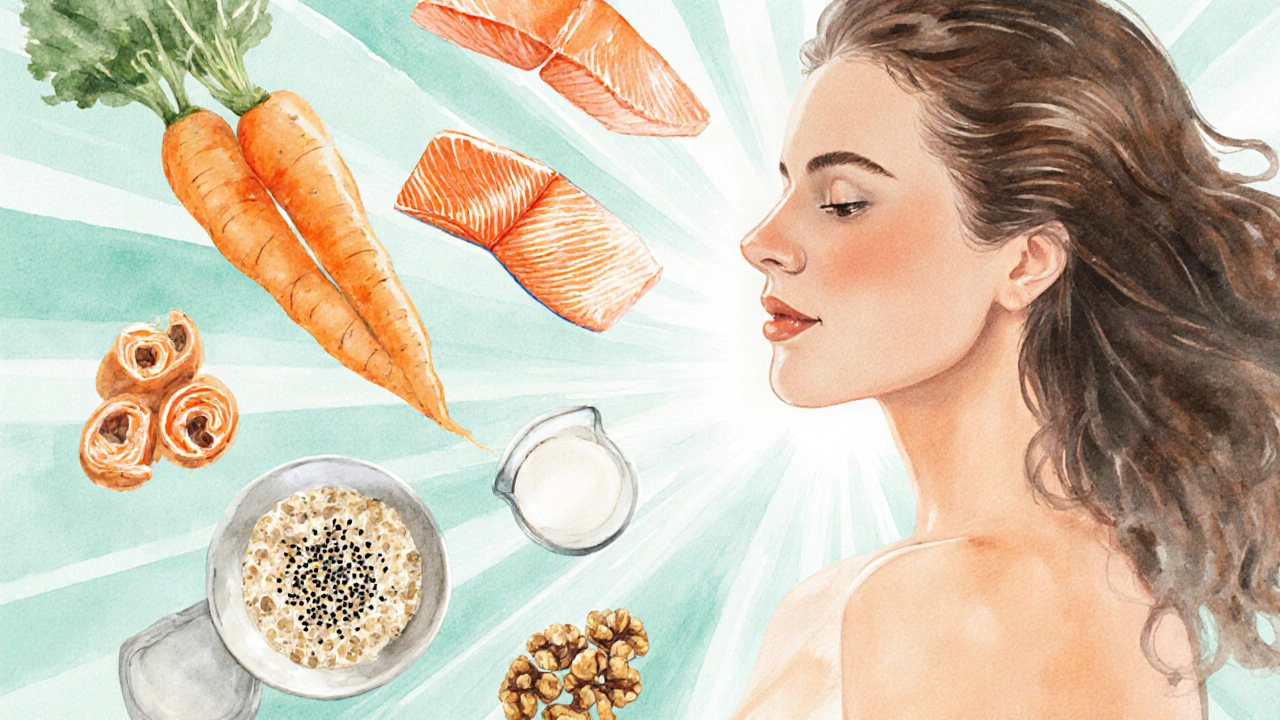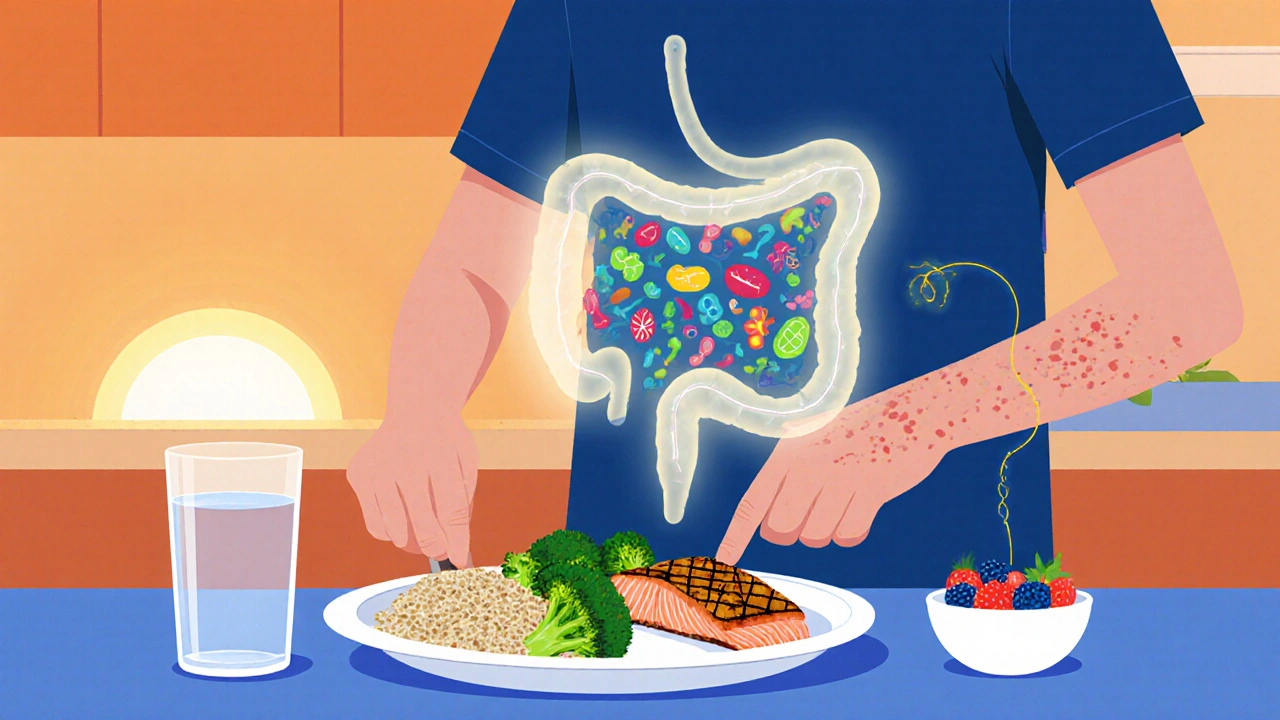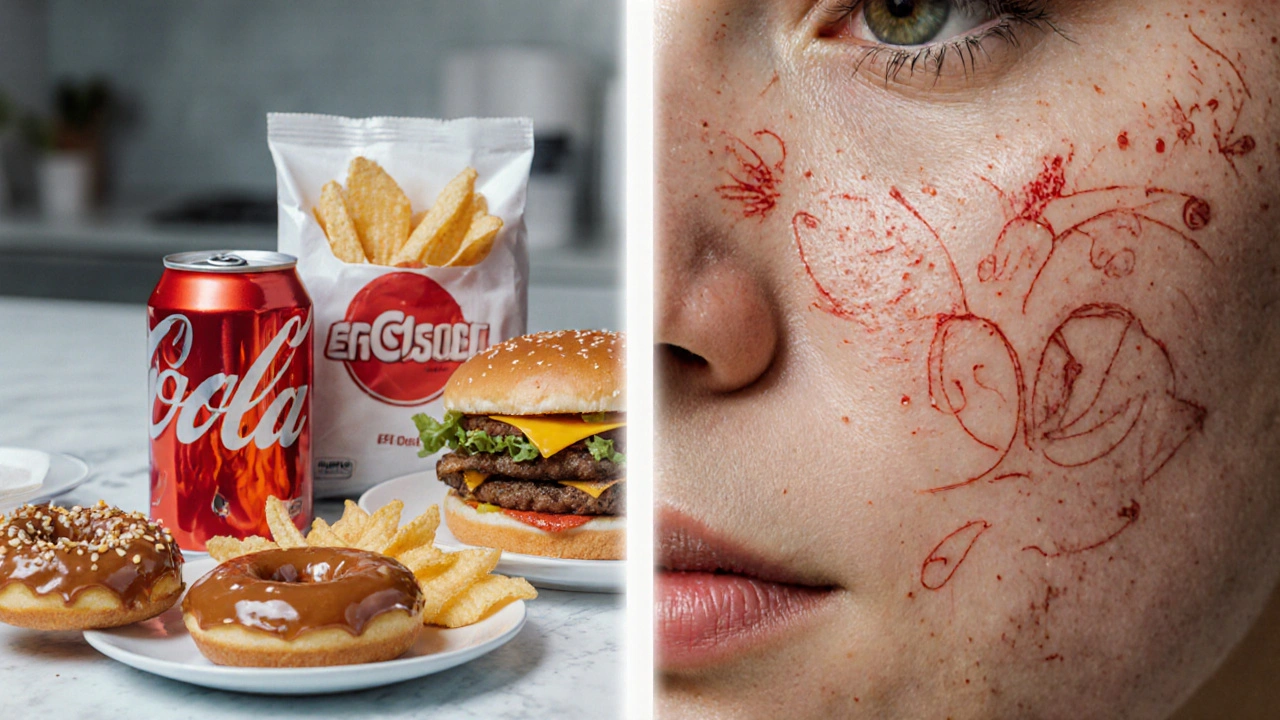Skin Health Diet Assessment
This assessment helps you understand how your current eating habits affect your skin health. Based on your responses, you'll receive a personalized score and tailored suggestions.
Your Skin Health Diet Score
Quick Takeaways
- High‑sugar and heavily processed foods can worsen acne, eczema and folliculitis.
- Fiber‑rich veggies, omega‑3 fats, and probiotic‑rich foods help keep the skin clear.
- Balancing gut microbiome is a practical way to lower flare‑ups.
- Key nutrients - vitamin A, zinc, and selenium - support the skin’s barrier.
- Small, consistent diet tweaks beat extreme ‘clean‑sees’ for long‑term skin health.
Ever wondered why a plate of donuts seems to spark a breakout the next day? The link between diet and skin infections isn’t hype - it’s backed by nutrition science and clinical observation. Below, we break down what to eat, what to ditch, and why the gut‑skin axis matters for conditions like acne, eczema, and folliculitis.
Diet is a set of habitual food and beverage choices that provide energy, macronutrients, and micronutrients to the body. How you feed yourself directly influences inflammation, hormone balance, and the health of the skin’s protective barrier.
Skin infection any bacterial, fungal, or viral condition that compromises the skin’s integrity, causing redness, pustules, or lesions often worsens when your diet fuels excess oil production or weakens immunity.
Why Certain Foods Trigger Skin Trouble
Not all foods are created equal when it comes to your skin. Two big culprits surface again and again in research:
- Sugar simple carbohydrates that rapidly raise blood glucose and insulin levels. A spike in insulin can increase sebum output and promote the growth of Propionibacterium acnes, the bacteria behind acne.
- Processed foods items high in refined carbs, unhealthy fats, and additives like sodium nitrite. They often contain omega‑6 fatty acids that tip the omega‑3/omega‑6 ratio toward inflammation.
In a 2023 randomized trial with 120 participants, those who added an extra 50g of added sugar per day saw a 30% increase in acne lesions over eight weeks, while the control group stayed flat.
Beneficial Nutrients for a Healthy Skin Barrier
Think of your skin as a brick wall; the bricks are skin cells, and the mortar is lipids and proteins. Certain nutrients act like stronger mortar, keeping the wall sealed.
- Vitamin A a fat‑soluble vitamin that promotes cell turnover and reduces hyper‑keratinization. Foods: sweet potatoes, carrots, liver.
- Zinc a trace mineral essential for wound healing and immune function. Foods: pumpkin seeds, oysters, chickpeas.
- Omega‑3 fatty acids polyunsaturated fats that dampen inflammatory pathways. Foods: salmon, flaxseeds, walnuts.
- Probiotics live microorganisms that support a balanced gut microbiome. Foods: yogurt, kimchi, kombucha.
These nutrients work together: vitamin A speeds up turnover, zinc repairs, omega‑3 calms, and probiotics keep gut‑derived inflammation in check.

Gut‑Skin Axis: The Hidden Connection
Research in the past five years shows a two‑way street between the gut microbiome and skin health. An imbalance (dysbiosis) can increase systemic inflammation, which then shows up as flare‑ups in acne, eczema, or folliculitis.
One 2024 meta‑analysis reported that patients with chronic eczema had 40% lower diversity of *Lactobacillus* species compared to healthy controls. Supplementing with a multi‑strain probiotic for eight weeks reduced eczema severity scores by an average of 1.8 points.
Comparison Table: Foods to Limit vs. Foods to Favor
| Category | Examples to Limit | Examples to Favor |
|---|---|---|
| High‑Sugar | Soda, candy, pastries | Berries, apples, oranges |
| Processed Fats | Fast‑food fries, microwave pizzas | Olive oil, avocado, nuts |
| Refined Carbs | White bread, white rice | Whole‑grain breads, quinoa, brown rice |
| Gut‑Friendly | Excessive alcohol, artificial sweeteners | Yogurt, kefir, fermented veggies |
| Anti‑Inflammatory | Processed meats | Fatty fish, chia seeds, turmeric |
Practical Meal Planning Tips
Implementing changes doesn’t require a full kitchen overhaul. Here are three easy steps you can start today:
- Swap one sugary drink for water or herbal tea. Over a month, this can cut daily added sugar by 20‑30g.
- Add a probiotic‑rich side at lunch-think a small cup of kefir or a handful of kimchi.
- Include at least two omega‑3 sources per week. A simple salmon fillet on Thursday and a flaxseed‑sprinkled oatmeal on Sunday cover the bases.
Track your skin’s response for four weeks. Most people see a noticeable decrease in red bumps after 2‑3 weeks of consistent changes.
When Diet Alone Isn’t Enough
While nutrition plays a big role, severe or persistent infections may need medical treatment. Topical antibiotics for folliculitis, prescription retinoids for acne, or corticosteroids for eczema flare‑ups are common. Pairing meds with dietary tweaks often speeds recovery and reduces recurrence.
Also, consider underlying conditions such as hormonal imbalances or autoimmune disorders that can amplify skin issues. A dermatologist or nutritionist can help tailor a plan that respects both medical and dietary needs.

Frequently Asked Questions
Can cutting out sugar really clear up acne?
Yes. Reducing added sugars lowers insulin spikes, which in turn reduces excess sebum production and the growth of acne‑causing bacteria. Most people notice fewer breakouts within 2‑4 weeks of a consistent low‑sugar diet.
What probiotic strains are best for eczema?
Studies point to *Lactobacillus rhamnosus* GG and *Bifidobacterium longum* as the most effective for reducing eczema severity. Look for supplements that list these strains with at least 1billion CFU each.
Is a low‑carb diet safe for people with folliculitis?
A moderate reduction in refined carbs can lower inflammation, but you don’t need to eliminate carbs entirely. Aim for complex carbs from whole grains and vegetables, which provide fiber that feeds good gut bacteria.
How much omega‑3 should I eat to see skin benefits?
Research suggests 1,000mg of combined EPA and DHA daily for noticeable anti‑inflammatory effects. That’s roughly a 3‑ounce serving of fatty fish or a teaspoon of algae‑based oil.
Can food allergies cause skin infections?
Yes. Allergic reactions can damage the skin barrier, making it easier for bacteria or fungi to invade. Common culprits include dairy, gluten, and nuts. An elimination diet under professional guidance can help pinpoint triggers.
Bottom line: your plate is a powerful tool for managing skin infections. By swapping sugar‑laden snacks for nutrient‑dense alternatives, feeding your gut with probiotics, and ensuring you get enough vitamin A, zinc, and omega‑3s, you give your skin the support it needs to stay clear and resilient.


Write a comment